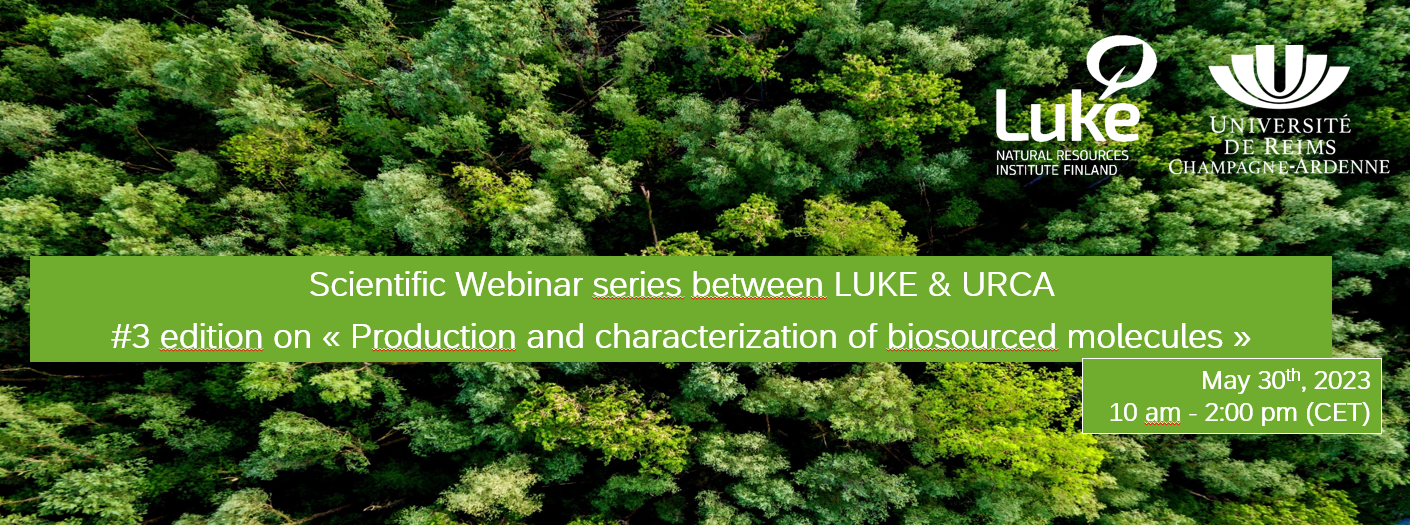The third edition of the Scientific Webinar series between LUKE & URCA took place on May 30th, 2023.
It gathered 60 attendees, researchers presented their work on « Production and characterization of biosourced molecules » .

The third edition of the Scientific Webinar series between LUKE & URCA took place on May 30th, 2023.
It gathered 60 attendees, researchers presented their work on « Production and characterization of biosourced molecules » .

Professor, Fractionation of AgroResources and Environment, UMR INRAE 614 FARE - URCA
« Biocatalysis to produce a large portfolio of biomolecules from agro-industrial co-products. »
The chaire AFERE and the FARE lab from URCA and INRAE study processes based onto white biotechnologies (microbial fermentation, biocatalysis) to valorize agro-industrial co-products into high added-value molecules for various applications.
The talk will focus onto the development of some innovative biocatalytic processes aimed to produce fermentescible sugars, oligosaccharides, alkyl glycosides, sugar esters or functionalized polyphenols that are of interest for the cosmetic, food and biofuel sectors. Examples of production of these biomolecules produced through hydrolysis, glycosylation or acylation biocatalytic reactions will be presented.

Senior Scientist, Biomass fractionation technologies, Production Systems, Natural Resources Institute Finland - LUKE
«Suberin fatty acids and triterponoids from birch outer bark. »
This presentation gives an overview of birch bark and its chemical composition. The separation of betulin and suberin fatty acids from birch outer bark is presented. Additionally, examples of the potential applications based on betulin and suberin fatty acids are given.

Associate Professor, Resistance Induction and Bioprotection of Plants, USC INRAE 1488 RIPB - URCA
« Use of plant cell system to produce potential ingredients for cosmetic application: an example with the Glycostil project through elicited grapevine cells. »
The aim of the presentation is to illustrate how grapevine cell cultures represent a good tool to study the biosynthesis and bioproduction of phytostilbenes. Using elicitors like methyljasmonate and cyclodextrins, we were able to produce several g/L of resveratrol and hundreds of mg/L of resveratrol derivatives in flasks, stirred bioreactors from 2L to 20L. These results gave rise to the project Glycostil funded by French ANR with Noveal L’Oreal group as a partner for potential cosmetic application.
Eric Courot's presentation is confidential.

Senior Scientist, Biomass fractionation technologies, Production Systems, Natural Resources Institute Finland - LUKE
« Enzyme-assisted extraction of blackcurrant press-cake: bioactivities of the extracts. »
Blackcurrants are popular throughout Europe, and are mostly consumed in a processed form. The berries contain phenolic compounds, such as anthocyanins, that show health beneficial properties. On the other hand they are also heat and processing sensitive, and for this reason mild technologies are sought to preserve those into the final product. When the berries are extracted for juice, the anthocyanin rich press-cake stays behind as a by-product and can be valorized in a biorefinery concept. Due to the sensitive compounds, green technologies, such as enzymatic treatment, can be of help to valorize the press-cake for which purpose enzymes of different nature are to be applied.
This presentation will introduce the effect of enzyme type on the efficiency of anthocyanin extraction from the press-cake, and the bioactivities of the extracts. Detailed discussion will be given on the antioxidant activities, in vitro cell based viability evaluation and ROS generation, antiviral activity and anti-inflammatory activity in the blackcurrant extracts.

Research Director, Molecular Chemistry Institute of Reims, UMR CNRS 7312 ICMR - URCA
« NMR-based identification of specialized metabolites. »
"The "CaraMel" workflow (Caractérisation de Mélange) was developed at the university of Reims for the quick identification of the known natural products within extracts. The last step in this workflow is the selection of candidate structures provided by the query of dedicated databases, using carbon-13 Nuclear Magnetic Resonance spectroscopy as primary source of information. The design and the use of such databases is discussed."